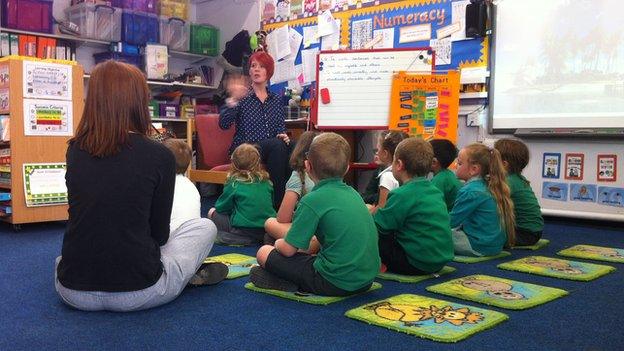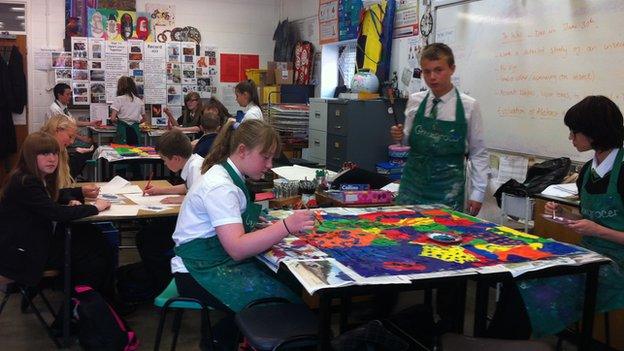Is academy status the answer for 'coasting' schools?
- Published

Meadow Primary School has joined an academy chain
It is a familiar formula in many ways.
The school down the road from you that's had a bad name among parents and falling pupil numbers is taken over and turned into an academy school.
The head teacher and the name will change, and there is a fair bet the discipline regime and uniform will too.
Making schools independent from their local council and giving head teachers much greater leeway in whom to hire, and what to teach, isn't new.
But until now, it has been applied to failing schools. The new Education Bill will extend that to "coasting schools".
The government clearly intends to draw that category quite widely, which could mean many more schools than expected facing pressure to improve.
The more obvious case for intervention is in local authority areas with large numbers of schools Ofsted says are less than good.
In Lowestoft, Suffolk, there are four secondary schools. Only one is rated as being good, two others have just come out of special measures, and one requires improvement.
Of the 20 primary schools, only eight are currently deemed to be good or outstanding.
New start
Tucked away behind streets of neat houses is Meadow Primary School.
The building is a little down-at-heel, but it is surrounded by beautiful playing fields and green spaces.

Nadia Paczuska has enlisted the local community to help improve the school
The school has chosen to begin a journey that hundreds more schools in England may be forced to follow in the coming years.
Meadow, rated as requiring improvement, is joining the primary-only academy chain REAch2.
Into this school has stepped a new head teacher, Nadia Paczuska, who was recruited through a scheme called Future Leaders, external.
She says: "It's very isolated geographically, there is high unemployment among the parents and the area surrounding the school, it's very difficult to recruit to this area and there's a sense of low expectation of the children."
In order to have enough teachers for the coming year she has recruited from Canada and Romania, and taken to social media to persuade teachers to relocate from around the UK.
The local neighbourhood is mainly white, typical of Lowestoft's long-established communities.
The school's standing had slipped, and there were some tense moments between parents and her predecessor, but Nadia says there is a will to change.
"Most of the parents I speak to are very conscious it's not good enough, and although it had perhaps become normalised it's certainly not something the community are happy about."
An appeal to the community to roll up its sleeves has led to volunteers offering to set up and run a library, and join a summer work party re-painting parts of the school.
Over the holidays, the school will also be running catch-up classes for pupils.
Which raises the question of whether it's Nadia's determination to lead a team improving the school that will make as much difference as becoming an academy.
It is easy to make a case for intervening in schools that are underperforming.
No guarantee
But Lowestoft also shows that simply becoming an academy, free from the management of the local council, is not a guarantee of success.
Many of the pupils from Meadow Primary will head towards what is now called East Point Academy.

East Point Academy has only recently been taken out of special measures
It became an academy in 2011, but by 2013 under the management of the troubled AET Academies chain it was in special measures, external.
There were concerns about poor teaching, truancy and bullying.
In 2014, just 32% of pupils got at least five GCSEs grade A to C, compared with the national average of 53%.
Now run by the Inspiration Trust, standards are rising and it was taken out of special measures, external in March this year.
Kevin Blakey, the principal, recognises he is up against a degree of scepticism from parents, staff and pupils because of the school's recent history.
He says: "It went into special measures as an academy and during that time in special measures it had four principals, and obviously with that comes some instability."
That is probably an understatement. So what exactly does he get out of being part of an academy trust?
As a new head, Kevin has been given a more experienced mentor, whom he meets each week to review progress and talk through problems.
And he tells me that because the academy chain is concentrated in nearby Norfolk, he is also calling on staff from its other schools, for example to check coursework marking.
The older Ofsted reports for the school, which used to be called Kirkley Community High School, are a depressing read.
They describe persistently low expectations of the largely white, working class kids attending the school.
Why intervene?
Which brings us back to the case for intervention.
Education Secretary Nicky Morgan told MPs, external the power to force underperforming schools to become an academy is about creating opportunities.
"We believe in a school-led system where experts have greater freedom but within a strong framework of accountability," she said.

Nicky Morgan says academy status helps create opportunities
"That is why we want more schools to benefit from the freedom that academy status brings."
But just last week, Ofsted warned, external another academy chain, which has expanded very rapidly, that many of its schools weren't improving quickly enough.
In particular, it said, that in schools run by Oasis Community Learning Trust: "Disadvantaged pupils, particularly boys, make significantly less progress than their peers nationally."
There are eight Regional Schools Commissioners who are meant to monitor the performance of academies and free schools.
They have very few staff and a job that is getting bigger.
It will also fall to them to implement the new powers to intervene in schools identified as coasting.
None was available to speak to the BBC before the draft regulations setting out the detail of the bill about how this will work.
The risk, says Tristram Hunt, shadow education secretary, is that "underperforming schools will simply pass from one poor provider to another, without the measures required to turn around sub-standard school leadership and classroom teaching."
The government says the difference is it can intervene more rapidly in a failing academy trust.
Impact on pupils
The question is whether that is rapid enough to make a difference for individual pupils.
People like 18-year-old David Stephenson, whom I met hanging out on the seafront at Lowestoft with friends.

Academy schools:
Academies are independent, state-funded schools, which receive their funding directly from central government, rather than through a local authority.
Although the day-to-day running of the school remains with the head teacher or principal, they are overseen by individual charitable bodies called academy trusts and may be part of an academy chain.
These trusts provide advice, support and expertise.
They have more freedom than other state schools over their finances and curriculum, and do not need to follow national pay and conditions for teachers.
As of June 2015, there are 4,676 academies open in England. There are hundreds more in the pipeline.
The number has grown dramatically under the coalition government, from 203 in May 2010.
Now over half of all secondary schools in England are academies.

David wants to be a welder and is now trying to gain skills at college.
But his school years were at Kirkley Community High in its troubled years, where he got into trouble and ended up in a student support unit.
"Basically I wasn't taught for a year and a half until I left that school. I got chucked into GCSEs without knowing anything. I was lucky to scrape out Ds."
David is clear what he thinks about how growing up in Lowestoft: "Pretty let down, because it's not the fact of where you should be that determines how good a school should be."
This in essence is the argument for intervening in areas like Lowestoft.
Taking a similar approach in areas where schools have broadly been told they are good will be more controversial.
Not least because the evidence around the academy model is mixed.
As Lowestoft has learnt, it is not a one-way ticket to success.